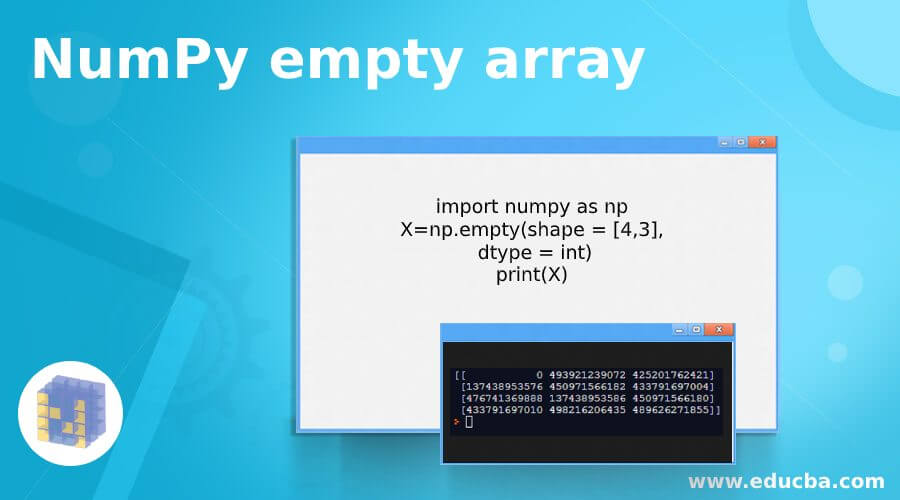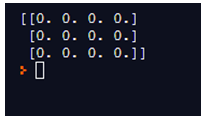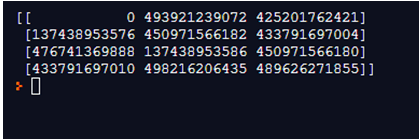Updated May 22, 2023

Definition of NumPy empty array
Python provides different functions to the users. To work with arrays, the Python library provides a numpy empty array function. It is used to create a new empty array as per user instruction means giving data type and shape of the array without initializing elements. An array plays a major role in data science, where speed matters. numpy is an acronym for numerical python. Basically, numpy is an open-source project. numpy performs logical and mathematical operations of arrays. Unlike list data structure, numpy arrays are designed to use in various ways. Therefore, processing and manipulating can be done efficiently.
Syntax and Parameters
Syntax and Parameters of NumPy empty array are given below:
Syntax:
array = np.empty (shape, dtype(data type), order='c')Explanation: As shown above, syntax it will give a new array with the shape and data type. As shown in the syntax where the array is array variable name and we define numpy empty array functions such as np. empty with the shape of the array and data types. The values returned by the array are random, and by default order of the array is c. It is used to define whether the array is multidimensional or not.
Parameters
- shape: It is used to determine the shape of the empty array. It can be int or a tuple of int. Ex: (3, 5) or 2.
- dtype: It is used to define the data type of an empty array, and it is an optional parameter. The default dtype of numpy is float64.
- order: It is used to determine in which order we store multi-dimensional data means C style (row style) or F style (column style).
How does empty array work in NumPy?
- We must install Python on your system.
- We must install numpy using the pip command.
- We required basic knowledge of Python.
- We required basic knowledge about arrays.
- We can perform different operations using a numpy empty function.
Examples to Implement NumPy empty array
Let’s see how we can implement a numpy empty array. Basically there are two ways to implement a numpy array as follows. But both are slightly different.
1. Using Numpy Empty Array Function
In this method, we implement a numpy empty array function. Let’s see an example for a better understanding.
Example #1
Code:
import numpy as np
sample_array = np. empty ((3,3))
print(sample_array)Explanation: We import numpy functions and use them as np. We declared variable sample_array and assigned values. We try to print the value of the variable.
In the above example, we implement a simple numpy empty array that returns uninitialized values with shape and data type. Illustrate the end result of the above declaration by using the use of the following snapshot.
2. Using NumPy Zeros Array Function
In this method, we implement a numpy array function efficiently, and after that, we are able to insert data row by row. Let’s see an example for a better understanding.
Example #1
Code:
import numpy as np
A = np.zeros([3, 4])
print(A)Explanation: We import numpy functions and use them as. We declared variable A and assigned values with zeros numpy function. Finally, we try to print the value of the variable
In the above method, we implemented the numpy zero function, and it returns all zeros. Illustrate the end result of the above declaration by using the use of the following snapshot.
Example #2
Code:
import numpy as np
A = np.empty([4, 4], dtype=float)
print(A)Explanation: In the above example, we follow the same syntax, but the only difference is that here we define the shape and data type of an empty array means we can declare the shape and data type. In the first example, we only declared shape. Illustrate the end result of the above declaration by using the use of the following snapshot.
Example #3 – For Order C
Code:
import numpy as np
A = np.empty([3, 3], dtype=float, order='C')
print(A)Explanation: We import numpy functions and use them as. We declared variable A and assigned values with an empty numpy function. Here we passed shape, data type, and order in the function. Finally, we try to print the value of the variable
In this example, we passed an order in function. Illustrate the end result of the above declaration by using the use of the following snapshot.
Example #4 – For Order F
Code:
import numpy as np
A = np.empty([2, 2], dtype=float, order='F')
print(A)Explanation: In the above example, we have only changed the order of the array. Illustrate the end result of the above declaration by using the use of the following snapshot.
Example #5 – For 1- Dimensional Empty Numpy Array
Code:
import numpy as np
A = np.empty(shape= 2)
print(A)Explanation: In the above example, we create a 1- dimensional empty array. Here only we use a single parameter shape. Illustrate the end result of the above declaration by using the use of the following snapshot.
The same example, we can execute without parameters.
Code:
import numpy as np
A = np.empty(3)
print(A)Explanation: In this example, we only pass shape size without any parameter. Still, the result is empty, which means Python allows us to do this. Illustrate the end result of the above declaration by using the use of the following snapshot.
Example #6 – For 2- Dimensional empty numpy array
Code:
import numpy as np
B = np.empty(shape= [3,4],dtype=int)
print(B)Explanation: We import numpy functions and use them as. We declared variable B and assigned values with an empty numpy function. Here we passed shape and data type in the function. Finally, we try to print the value of the variable.
In this example, we passed an order in function. Illustrate the end result of the above declaration by using the use of the following snapshot.
Example #7 – To obtain the exact data type of empty numpy array
Code:
import numpy as np
X=np.empty(shape = [4,3], dtype = int)
print(X)Explanation: In this example, we passed shape size and specific data type of empty numpy array in the function. Illustrate the end result of the above declaration by using the use of the following snapshot.
Conclusion
We hope from this article, you have understood the numpy empty array function. From the above article, we have learned the basic syntax of numpy empty arrays. We have also learned how we can implement them in Python with different examples empty arrays as well as zeros functions. From this article, we have learned how we can handle numpy empty arrays in Python.
Recommended Articles
We hope that this EDUCBA information on “NumPy empty array” was beneficial to you. You can view EDUCBA’s recommended articles for more information.










